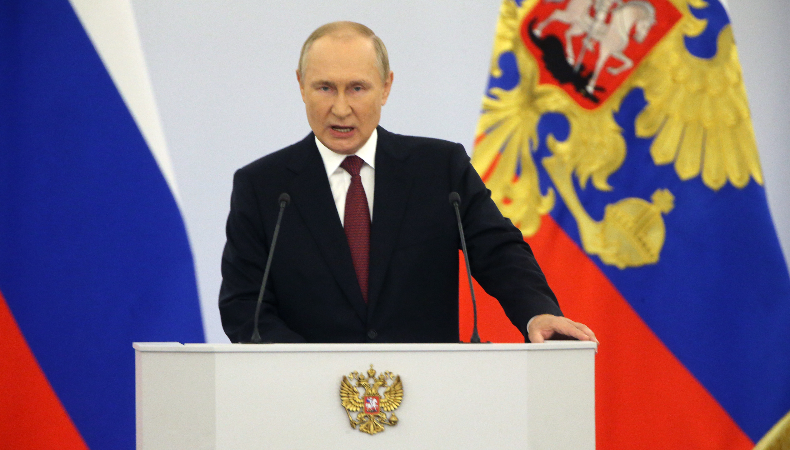Putin Expands Russia’s Nuclear Doctrine: New Rules for Retaliation Amid U.S. Missile Support to Ukraine

Officially supporting major changes to the country’s nuclear policy, Russian President Vladimir Putin is extending the circumstances under which nuclear weapons could be used. Reflecting Moscow’s growing discomfort with the geopolitical issues it faces, especially in its confrontation with Ukraine and rising tensions with the West, the updated framework presents more broad scenarios that justify nuclear response.
Formally scheduled on Tuesday, the symbolic 1,000th day since Russia’s full-scale invasion of Ukraine began—signals a change in the Kremlin’s attitude toward supposed dangers. Moscow has denounced as a reckless escalation the United States’ decision to approve Ukraine’s use of powerful, long-range ATACMS missiles to hit Russian territory closely follows.
https://x.com/BRICSinfo/status/1858787864990843142
What changes Russia’s Nuclear Doctrine?
The updated theory now states that any strike by a non-nuclear state, should it be supported or backed by a nuclear power, will be seen as a concerted attack against Russia, maybe justifying a nuclear reaction. Given the NATO coalition’s continuous support of Ukraine, this shift emphasizes the Kremlin’s growing view of Western partnerships as direct dangers.
The revised criteria surpass conventional nuclear triggers. For nuclear reprisal, for instance, a massive conventional attack employing missiles, drones, or aircraft may potentially qualify. Russia has also said that an attack on Belarus, its closest friend and a strategic partner in the war, may set off the same reaction as one on Russian territory.
Moscow’s posture on coalition-led aggression is another noteworthy inclusion. Any military action taken by a coalition member—including NATO—will today be seen as a collective act of aggression. This classification considerably increases the range of countries and military scenarios that might cause Russia to turn to nuclear alternatives. According to state-run news source Tass, the doctrine strengthens Russia’s capacity to justify a nuclear reaction under changing geopolitical conditions while widening the spectrum of perceived threats.
Why Right Now the Doctrine Matters
Emphasizing its relevance in the geopolitical environment of today, the Kremlin justified the timing of the disclosure. The revised doctrine, according to Kremlin spokesman Dmitry Peskov, is “a very important text” requiring thorough study by other countries. According to Peskov, Putin had earlier this year ordered the changes to guarantee they fit “current reality.” He also pointed out that the publication was deliberate, stressing its publication during a time of rising tensions and more scrutiny of Russia’s worldwide stance.
The modifications also fit more general worries about how warfare is changing. With drones, cyberattacks, and long-range missile strikes playing ever more important roles in modern conflict, the Kremlin’s changes reflect its attempt to present itself as poised to sharply address these threats.
https://x.com/visegrad24/status/1858801773793964049
American ATACMS Missiles in Ukraine Start warnings from the Kremlin
Just one day after U.S. President Joe Biden’s government approved Ukraine’s employment of long-range ATACMS missiles, capable of targeting Russian land far beyond the front lines, the acceptance of the revised doctrine came. Moscow has denounced this development as a direct provocation while Kyiv has embraced it as a vital upgrade to its military might.
The strongly worded statement issued by Russia’s foreign ministry warned that any strike on Russian territory using these missiles would reflect “direct involvement” by the United States and its allies in the continuing fight. Though it refrained from outlining particular actions, the ministry vowed “an appropriate and tangible response,” suggesting possible retaliatory measures.
Peskov repeated similar ideas, stressing that the updated policy was released “in a timely manner” to reflect what the Kremlin sees as a progressively hostile Western posture. Given NATO’s ongoing support of Ukraine, he said the inclusion of coalition-based threats was especially important.
Ukraine has discounted the doctrine modifications as another instance of Putin’s “nuclear saber-rattling,” meant to discourage Western countries from offering more military support. Arguing that such warnings are essentially psychological warfare meant to erode international determination rather than reflect an instant change in tactics, Ukrainian authorities urged their friends to be relentless.
Concerned with the developments, Western authorities have warned that they may compromise world security even further. Expanding the spectrum of possibilities for nuclear reprisal, according to critics, raises the possibility of miscalculation, especially in a high-stakes situation such as the conflict in the Ukraine. The uncertainty of the theory on what qualifies as a “critical threat” to Russian sovereignty also allows for a wide interpretation, therefore aggravating relations with NATO and other world powers.
Changing the Nuclear Story: Rising Profile
Putin has used nuclear hyperbole in the Ukraine war before now. Often in response to more Western involvement, the Kremlin has sporadically suggested the prospect of nuclear escalation since the start of the war. Although many of these dangers have been written off as posturing, the official revisions to Russia’s nuclear policy point to a more determined approach to include nuclear considerations into its conventional military plans.
Experts say the changes accomplish several goals. Domestically, they support Putin’s image as a powerful leader able to defend Russia against outside dangers. Globally, they serve as a deterrence, warning the West that any more backing of Ukraine could have dire effects.
The revised Kremlin doctrine has caused waves in the world community and sparked concerns about a fresh nuclear weapons race. Russia has increased the stakes for its rivals by extending the parameters under which nuclear weapons could be used, therefore complicating diplomatic efforts to resolve the Ukraine crisis.
Nuclear conflict looms bigger than ever as world leaders consider the ramifications of Moscow’s changed posture. The focus on coalition-based aggression of the doctrine and the inclusion of non-nuclear threats point to a risky change in Russia’s view and reaction to outside challenges. This scenario emphasizes the need for increased awareness and coordinated worldwide actions to stop more escalation in one of the most unstable times of contemporary history.




